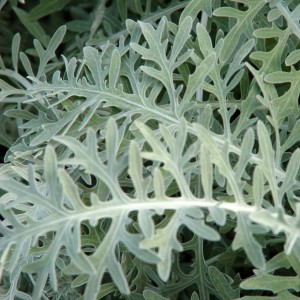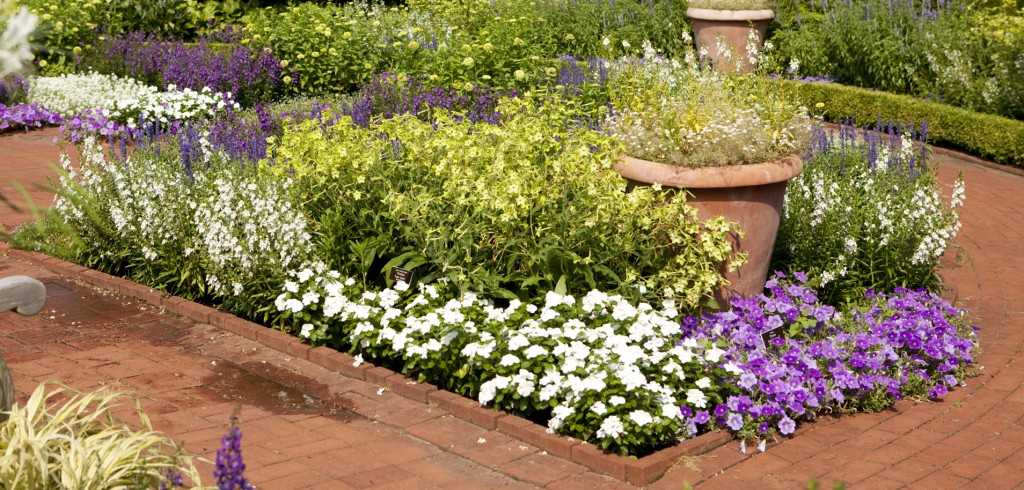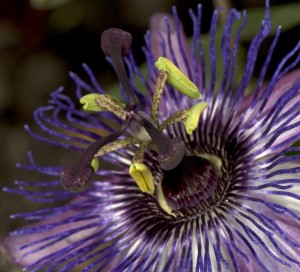Plant Profiles: Unusual Annuals Continued…
Posted in Gardening Tips, Gardens and Collections on July 31 2012, by Sonia Uyterhoeven
Sonia Uyterhoeven is the NYBG‘s Gardener for Public Education.

Sometimes the ordinary can look extraordinary just by making a few changes. This is the case with dusty miller (Centaurea cineraria) in the Home Gardening Center. In one of the beds we have ‘Gloucester White’ growing alongside Salvia ‘Wendy’s Wish’ and Petunia Supertunia® ‘Vista Silverberry’. This is how you would expect to see it in a display–partnered in a nice color combination with other annuals.
In an adjacent bed, however, we have done something different. The same dusty miller, ‘Gloucester White’, has been grown into a standard. The two specimens that you see are between four and five years old. Dusty miller is a vigorous grower and forms a woody stem fairly quickly, making it an ideal candidate for a standard.
If you feel like a fun, slightly challenging project, you can train your dusty miller into a standard or small tree form by taking a cutting of the plant and letting it grow (or buying a young plant). If you are growing your young standard in the home, remember to rotate the pot (1/4 turn weekly) to ensure that all sides of the plant receive an equal amount of sunlight. This will ensure that it grows nice and straight.
Once it has reached a good height, stake the stem and remember to check the ties every month to make sure that they are not too tight. As you let the dusty miller grow, be careful to remove any buds that form on the main stem. You do not want your plant to branch. You are trying to create a nice, strong upright stem. All of the energy will go into the top growth and encourage it to grow upright.
Continue to let it grow until it has reached its desired height. Once there, pinch the central leader to encourage the branches on the top to start forming a round head. Pinch the branches back on the top 1/3 of the plant so that it continues to fill out nicely. We have done this with coleus and chrysanthemums as well as dusty miller in the Garden. It makes a wonderful centerpiece.

Another way to create height in the garden is to grow vines. We have a relatively new cultivar of thunbergia–or black-eyed Susan vine–growing in the Garden, named Thunbergia alata Raspberry Smoothie™. It grows four to six feet tall and has lavender pink flowers with a magenta throat.
Raspberry Smoothie™ prefers full sun and thrives in rich, well-drained soil. Like most annuals, it is important to deadhead consistently so that it continues to flower throughout the season. Fertilize every two weeks with a ½-strength liquid fertilizer. The vine is putting on a lot of growth during the summer months and in order for it to flower profusely it will need to be fed. If it starts growing out of bounds, just trim it back to shape.
We also have a number of passion flowers growing up trellises in the garden this year. The ones in the containers have been fine. The ones planted in the ground have been decimated by an adorable pint-sized rabbit. The vine is vigorous so it has continued to grow–even after being mowed to the ground. We have erected black wire cages around them as a deterrent. It has worked, meaning the rabbit is now off eating the papyrus.

Some of the varieties of passion flower that we are featuring in the garden are Passiflora ‘Purple Tiger’, ‘Blue Bouquet’ and ‘Blue-eyed Susan’. They are all incredibly ruffled and ornate with their own personalities. These vines do not have to be deadheaded and pruning is only necessary to keep them in their bounds. Pruning will also encourage branching and result in a fuller plant.
Vines are a nice way to bring height into your container plantings and your borders. Annual vines mean that you can experiment every year with something new. We have some nice sturdy trellises that we can reuse every year; otherwise, large bamboo stakes are an effective and appealing way of staking large vines.

